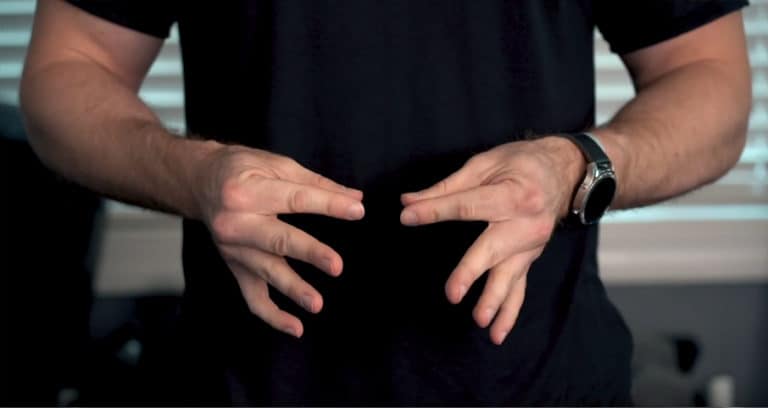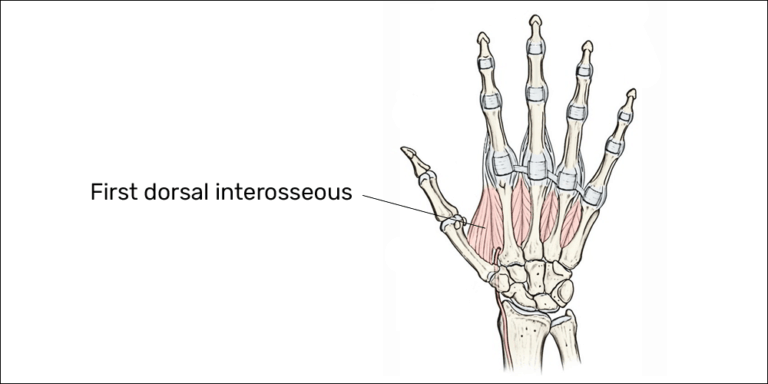Claw grip for controller users: 7 steps to stay healthy
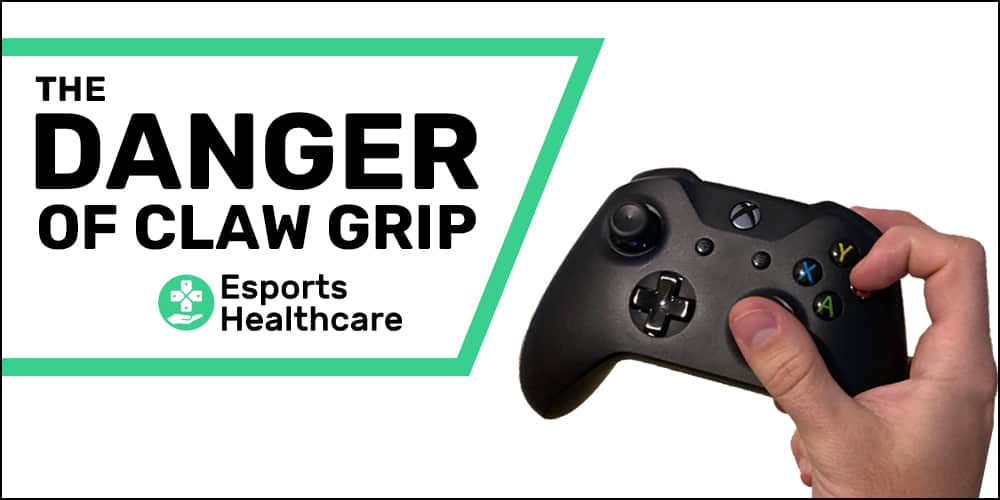
Disclaimer
This information is for educational purposes only and is not intended to replace the advice of your doctor. Esports Healthcare disclaims any liability for the decisions you make based on this information.
The information contained on this website does not establish, nor does it imply, doctor-patient relationship. Esports Healthcare does not offer this information for diagnostic purposes. A diagnosis must not be assumed based on the information provided.
Console gaming has evolved to include some extravagant button combinations for gamers to control their characters’ movements, attacks, and defenses. Some players elect to use paddles to keep up while others continue to use traditional console controllers.
For those who continue to stick with the traditional button layout, a large population of gamers have turned to use the claw grip for controller mastery. Unfortunately, this play style is not without risks. But, if you are one of those claw grip controller users, don’t worry—we’re here to help keep your hand safe!
Unfortunately, due to its smaller dimensions, a PS4 controller creates a more significant risk for fatigue, pain, and injury. Xbox controller risk still exists, but PS4 gamers using claw grip will likely experience more significant issues.
What is the claw grip for controller users?
The claw grip for controller users is a technique that allows players to press the controller buttons while keeping their thumb on the right stick and the middle finger on the trigger(s). This technique prevents the need to sacrifice even a split second of aim in order to tap a button for an attack, defense, or other game mechanic.
The claw grip for controller users was a name coined due to the flexed index finger position over the buttons on a standard console controller—creating a claw-like or hook-shaped appearance to the index finger.
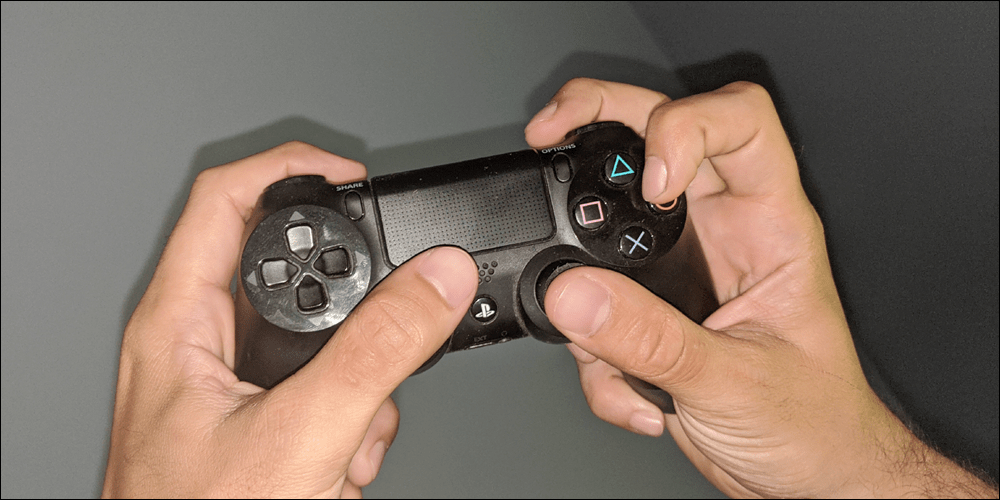
While this position is exceptionally efficient for the use of a standard console controller, it creates a unique strain on the index finger, its muscles, and the surrounding joints which may lead to pain, repetitive strain, and the potential for long-term dysfunction.
Fortunately, these issues are all avoidable! If you currently use or want to use the claw grip for controller but are worried about the risks, continue reading. We’ll teach you all about the risks involved and how you can prevent any injury, ailment, or pain.
Muscles of the claw grip
When you use the claw grip for controller (Xbox, Playstation, or any other), there are five muscles that may be involved. The fashion in which these muscles are engaged creates the potential for pain and injury risk—specifically, in your index finger.
In order to understand why the risk exists, it is important to first understand the anatomy of the hand and fingers.
First dorsal interosseous: the #1 culprit
This muscle will abduct (separate) your index finger from the rest of your hand. In the claw grip, abduction of your index finger will lift it off the face of the controller, and this is how you are able to prevent your finger from constantly pressing all the buttons.
Additionally, the first dorsal interosseous muscle will flex the metacarpophalangeal (knuckle) joint of your index finger (as would occur while making a fist) but will extend the proximal and distal interphalangeal joints (the two joints) of your index finger.
Therefore, the first dorsal interosseous muscle is constantly activated while using the claw grip! Below, in Major concerns: fatigue, pain, and injury and Mechanism of muscle and tendon injury, we discuss this muscle’s role even more extensively.
Extensor digitorum
This muscle creates extension of your wrist and 4 fingers (opening your hand and bending your wrist back towards the knuckle-side of your hand). For the claw grip, this muscle will be most active in pulling your middle finger off the trigger and extending your index finger back upwards (e.g., to reach Y and B on Xbox or Triangle and Circle on Playstation).
Extensor indicis
This muscle creates extension of your index finger (as in pointing). For the claw grip, this muscle will be active to allow your index finger to reach Y and B on Xbox or Triangle and Circle on Playstation.
Flexor digitorum superficialis and profundus
These two muscles create flexion of your wrist and 4 fingers (closing your hand and bending your wrist towards the palm side of your hand). For the claw grip, these muscle will be most active in pressing your middle finger down on the triggers and flexing your index finger downward off the trigger (e.g., to reach any of the four buttons on Xbox or Playstation).
Major concerns: fatigue, pain, and injury
The mechanics of the claw grip for controller require significantly greater activation of the first dorsal interosseous (FDI) muscle compared to the other muscles listed—making it the unquestionable leading cause of fatigue, discomfort, pain, and dysfunction using this technique.
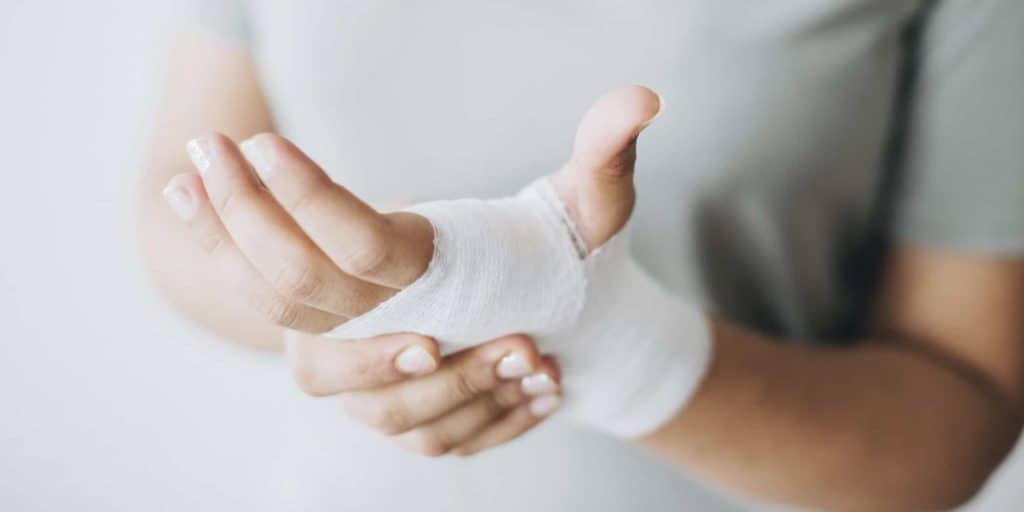
Mechanism of fatigue and pain
While gaming with a claw grip for controller, you will need to maintain prolonged, isometric contractions of the FDI muscle throughout the duration of your match. These prolonged contractions will lead to fatigue.
Intense, acute muscle fatigue most often presents as a burning sensation. This is the same sensation you may experience during bouts of high-intensity exercise such as sprinting or weight lifting. This occurs due to lactic acid building up from prolonged, static contraction and/or rapid, repetitive contractions—which will both occur while using claw grip for controller.
Fatigue also leads to a decrease in contractile velocity (slower activation) in the FDI which controls how fast you can tap the buttons on your controller. One research study reported alterations in post-fatigue muscle firing of the FDI, but also reported a return-to-normal contractile velocity following a 10-minute rest period.
In other words, take breaks between matches, and schedule longer (10-minute) breaks within your long gaming or streaming grinds to prevent chronic fatigue and limit muscle firing alterations!
Mechanism of muscle and tendon injury
The mechanism of injury can be categorized as a movement imbalance. This is the same mechanism of injury for tendinopathy strains such as mouse elbow, mouse shoulder, and medial epicondylosis. In reference to the claw grip for controller, we have summarized the issues below.
Concentric vs. eccentric imbalance
When concentric (shortening) contractions occur too frequently without the counterbalance of eccentric (lengthening) contractions, collagen (the main type of tissue in tendons) begins to degenerate from the chronic shortening. Eccentric contraction—the lengthening of a muscle and tendon under tension—helps maintain the tendon fiber orientation.
Concentric contraction of the FDI is constant—abduction of the index finger off the face of the controller, flexion of the MCP joint, and extension of both the PIP and DIP joints. There is absolutely no instance of eccentric contraction for the FDI while using a claw grip, and eccentric contraction protects muscles and tendons from overuse injury!
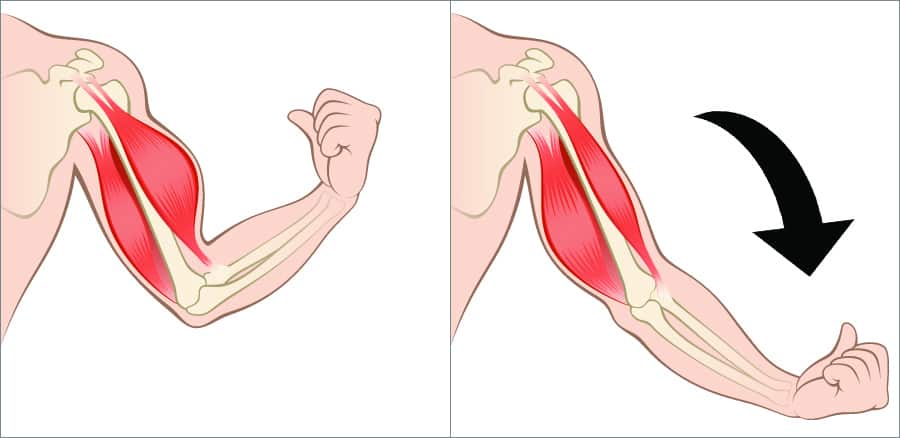
Agonist vs. antagonist imbalance
When agonist (prime mover) muscle actions occur too frequently without the counterbalance of their antagonist (opposing the primary movement), there is imbalance in the strength and tension on the joints involved. When strength and tension are not balanced, the muscles can be overworked and injury becomes more common.
Agonist action of the FDI, exactly like its concentric action, is constant because all three major actions of the claw grip are initiated by the same muscle. The opposing action—adduction (squeezing your fingers together side-by-side)—is not a significant action of the index finger. Instead, a combination of MCP, PIP, and DIP flexion and extension allow you to navigate the buttons.
Adduction of the index finger would cause the base and side of your index finger to press against the controller face rather than your finger tip pressing the individual buttons.
How to prevent and resolve fatigue, pain, and injury
To prevent or resolve any prolonged fatigue, pain, or injury you’ve experienced while using the claw grip for controller, you’ll need to step back and re-evaluate your approach to gaming and/or streaming.
Step 1. Complete a proper warm-up
First, recognize that a proper warm-up is absolutely essential—not only to prevent pain and injury but also to improve your gaming performance. Our warm-up routine is comprehensive to include all muscles and joints involved in your gaming sessions, including the first dorsal interosseous.
Step 2. Take breaks while gaming
As previously mentioned, researchers found that a 10-minute rest period helped to normalize muscle function including contractile velocity (speed) and maximum voluntary contraction (strength). Do yourself a favor, and take breaks between matches. Additionally, schedule longer (10-minute) breaks intermittently during long hours of gaming.
If you’ve read through our page outlining habits of healthy gaming, you’ll know that stretching is important but not until your entire session is over. DO NOT stretch your muscles during these intermittent breaks! To stay loose, repeat some of the exercises and movements in the warm-up. Stretching mid-session may decrease your performance and will not effectively aid in injury prevention.
Step 3. Check your posture
At Esports Healthcare, so much of what we teach comes from the foundation of body mechanics—namely, your posture. The importance of posture for preventing fatigue, pain, and injury while using the claw grip for controller is specific to the nerve that controls the first dorsal interosseous muscle (FDI)—the ulnar nerve.
The ulnar nerve travels along the medial (inside) aspect of your arm and forearm and is most well-known for its sensory distribution to your pinky, ring finger, and the pinky side of your hand. Most people know it as the “funny bone” nerve. However, it is also the motor nerve for the FDI muscle.
Thus, the ulnar nerve is the most valuable peripheral nerve for those who use claw grip for controller! So, do yourself a favor and avoid leaning your elbows on your thighs or against hard-surfaced armrests. Be mindful of the compression that may occur—known as cubital tunnel syndrome—as this may lead to more rapid fatigue, pain, and injury of the FDI muscle.
Step 4. You are what you eat and drink
Do not underestimate the absolutely invaluable aspect of nutrition. Eating unhealthy foods or consuming unhealthy beverages will simply make your body unhealthy. Check out our page describing our favorite healthy gamer snacks for better snack options during your gaming sessions.
To learn more about nutrition, in general, check out our pages on the basics of nutrition and how to read nutrition labels.
Also, drink plenty of water. Generally, the recommendation for fluid intake is half your body weight (measured in pounds) in fluid ounces per day. So, if you weigh 120lbs, you should drink 60 fl. oz. If you weigh 160lbs, you should drink 80 fl. oz, and so on.
Step 5. Rest and recovery
We will never tell you to stop gaming. However, your rest and recovery are important. Taking breaks between games and matches is part of that, but your recovery after and between these long sessions is even more important.
Post-session stretching
When you’re done gaming, and you won’t be gaming again until tomorrow or later, it is time to stretch! We have a stretch routine to assist in the prevention of aches, pains, and injuries that gamers may face. Following physical activity, stretching may increase range of motion and release chronic tension in muscles.
The unmatched importance of sleep
In life, there is not one single thing more valuable to your health than your sleep. Please, read our post on sleep to better understand its importance. And, for the sake of your health, schedule and commit to a regular sleep schedule including eight hours of uninterrupted sleep!
Step 6. Therapy techniques and exercises
If you presented to one of our offices for treatment of pain or injury caused by using claw grip for controller, our treatment protocols would be relatively simple yet highly effective.
Manual therapy (“massage”) to the muscle
We wouldn’t perform a “massage,” per se, but we would perform manual therapy techniques that may look similar to a massage. The techniques used in our facilities include pressure release (also known as “ischemic compression”), cross-friction, and fascial manipulation.
First, you need to identify the first interosseous muscle. To do so, perform the claw grip and accompanying movements on your controller, and feel for the contraction of the muscle below the base of your index finger. The muscle belly will expand and feel firm when you begin to use it.
Pressure release or ischemic compression
This technique includes pressing or squeezing the belly of the muscle in question, pressing the blood out and limiting the blood flow in for a short duration of time (often 30 seconds to 1-minute).
Use your thumb to press the muscle into the side of your hand. Alternatively, use your other index finger and thumb to pinch the “thumb web” and apply moderate pressure to the muscle. Squeeze and hold for 30 seconds to 1-minute Unfortunately, these techniques will likely be moderately painful.
Perform this technique only one or two times per session, and perform, at most, 3 days per week with at least one day between.
Cross-friction
Rather than pressing and holding, you may opt to strip the muscle cross-wise. This technique, called cross-friction, will also press out stagnant blood and allow fresh, oxygen-and-nutrient-rich blood to fill the muscle in its place.
Use your other thumb or the 2nd knuckle of your index finger to press into the muscle (along the side of your hand). With moderate pressure, scrape across the muscle for 15-30 seconds at a time. Likewise, this technique will likely be moderately painful.
Perform this technique only two or three times in one session, and perform, at most, 3 days per week with at least one day between.
Exercises and stretches for rehabilitation
The first dorsal interosseous muscle is a difficult one to stretch. Crossing your index finger and middle finger is one way to create a gentle lengthening of the FDI. Additionally, we can stretch the “thumb web” which includes a gentle stretch of the target muscle. For either stretch position, keep it gentle! Do not pull your index finger across your middle finger or pull your thumb back too heavily!
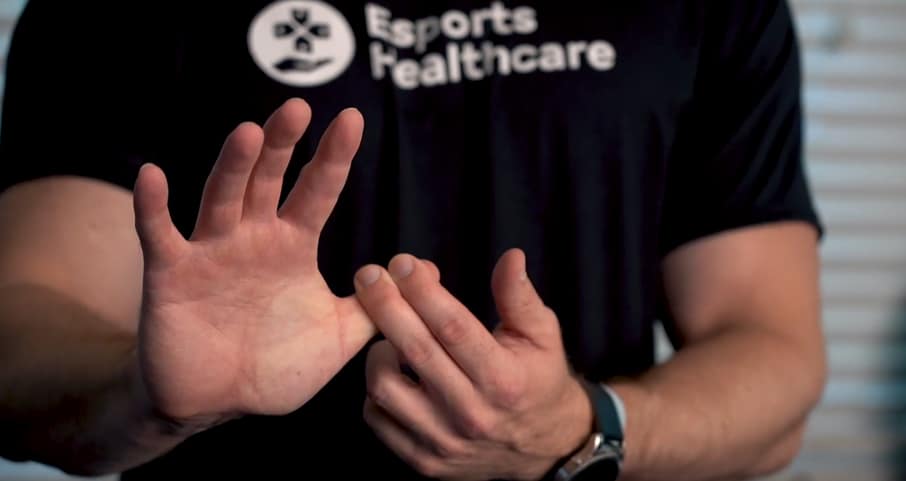
One other beneficial exercise is the ulnar nerve glide. Since the FDI is innervated by the ulnar nerve, it is important to keep that nerve free of tension or irritation. One way to achieve this is by performing the ulnar nerve glide.
- Begin with your elbow outward and your hand at your waist making a circle with your thumb and index finger.
- Keeping your elbow flared outward, raise your hand toward your face.
- Do not push beyond a feeling of tension in your forearm, pinky or ring finger.
- Repeat steps 1 and 2 for a total of ten (10) repetitions.
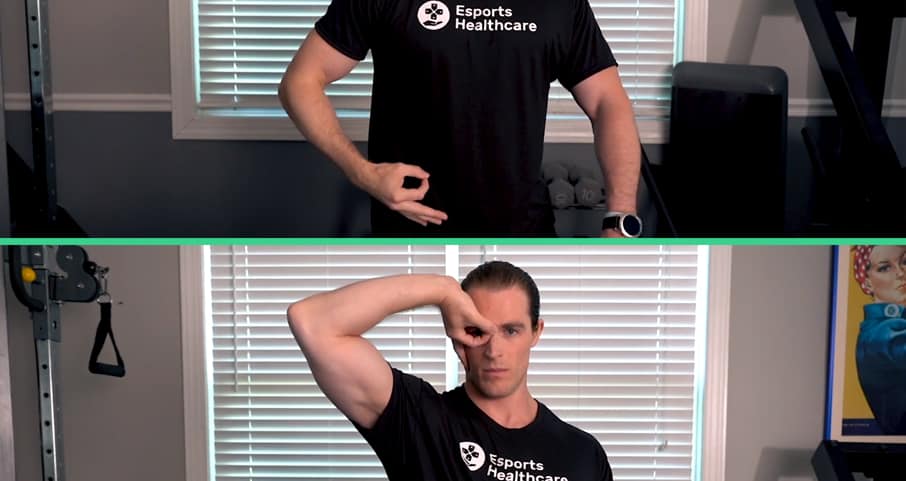
Step 7. Heat or contrast therapy
If you experience fatigue or pain without inflammation, try using heat on your hand and fingers while you’re not gaming. Heat will help to dilate (open) your blood vessels, increasing blood flow to the area. This increase in blood flow can help eliminate toxins while bringing oxygen and nutrients to the muscles in need.
Note: inflammation is categorized as pain with redness, swelling, and heat. These 3 factors indicate an increase in blood to the area of concern.
If you experience pain with inflammation, we suggest contrast therapy. Begin with heat on the area for ~10 minutes. Following ~10 minutes of heat, replace it with ~10 minutes of ice or cold therapy. Contrast therapy will open the blood vessels to help eliminate toxins followed by clamping the blood vessels and preventing excess inflammation.
Anti-inflammatory medication
As chiropractors and providers who are not established as your doctor, we cannot and do not recommend anti-inflammatory medication.
However, if inflammation exists (pain with redness, swelling, and heat), non-steroidal anti-inflammatory drugs (NSAIDs) such as ibuprofen (Advil), naproxen (Aleve), aspirin, or acetaminophen (Tylenol) may be useful.
If you’re interested in taking NSAIDs or any other medication, our official advice is that you must first speak with your doctor.

